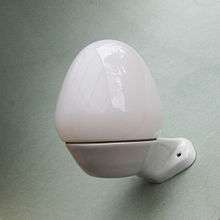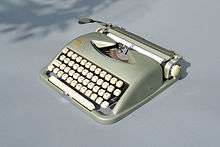Wilhelm Wagenfeld


Wilhelm Wagenfeld (* 15 April 1900, Bremen, Germany — † 28 May 1990, Stuttgart, Germany) was an important German industrial designer of the 20th Century, disciple of Bauhaus. He designed glass and metal works for the Jenaer Glaswerk Schott & Gen., the Vereinigte Lausitzer Glaswerke in Weißwasser, Rosenthal, Braun GmbH and WMF. Some of his designs are still produced to this day.[1]
Biography
Wagenfeld studied under the direction of László Moholy-Nagy at the Bauhaus. He became an assistant at the Bauhochschule Weimar in 1926.[2]
Work
Wagenfeld believed that everyday household objects should be "cheap enough for the worker and good enough for the rich."[3]

One of his classics is a table lamp, known as Wagenfeld Lampe, 1924, which he designed together with Karl J. Jucker. In cooperation with Charles Crodel his works found their way into exhibitions and museums. Thereto Crodel developed a patented decoration technique for the industrial mass production.[4] His famously stripped-down tea service, designed in 1938 in Hitler's Germany, is still in production.[5]
Legacy

Wagenfeld House, a brief walk from the Kunsthalle Bremen, is a museum dedicated to the work of the Bremen-born Bauhaus designer. It was originally built in 1828 as a neoclassical jail, later used for interrogations by the Gestapo and, until the 1990s, offered crowded accommodation to unsuccessful asylum-seekers awaiting deportation. Wagenfeld House also houses the Design Center, which sponsors symposia and provides a forum for young designers.[6]
There is a design school in Bremen named after him, the Wilhelm-Wagenfeld-Schule.
Wilhelm Wagenfeld's grandson Malte Wagenfeld[7] is senior lecturer and program director for industrial design at the RMIT University in Melbourne, Australia.
Bibliography
- Manske, Beate, ed. (2000). Wilhelm Wagenfeld: (1900-1990) (hardcover) (in German). Ostfildern: Hatje Cantz Verlag. p. 224. ISBN 978-3-7757-0885-2. out-of-print
- Manske, Beate, ed. (2000). Wilhelm Wagenfeld: (1900-1990) (hardcover). Ostfildern: Hatje Cantz Verlag. p. 208. ISBN 978-3-7757-0885-2. out-of-print
- Manske, Beate, ed. (2005). Wilhelm Wagenfeld: (1900-1990) (softcover) (in German). Ostfildern: Hatje Cantz Verlag. p. 224. ISBN 978-3-7757-1660-4. out-of-print
- Manske, Beate; Scholz, Gudrun, eds. (2005) [1987]. Täglich in der Hand: Industrieformen von Wilhelm Wagenfeld aus sechs Jahrzehnten [Daily in His Hand: Industrial Forms of Wilhelm Wagenfeld from Six Decades] (softcover) (in German) (5 ed.). Achim: Beste Zeiten Verlagsgesellschaft mbH - Worpsweder Verlag. p. 346. ISBN 3-88808-550-0.
- Scheiffele, Walter (1994). Wilhelm Wagenfeld und die moderne Glasindustrie [Wilhelm Wagenfeld and the Modern Glass Industry] (clothbound) (in German). Ostfildern: Hatje Cantz Verlag. p. 316. ISBN 978-3-7757-0488-5. out-of-print

References
- ↑ "Designer Spotlight Wilhelm Wagenfeld". interior-deluxe.com. Retrieved April 7, 2014.
- ↑ Hauffe, Thomas (1998). Design. Great Britain: Laurence King Publishing. p. 130. ISBN 1 85669 134 9.
- ↑ David Galloway (May 30, 1998), City Has Rejuvenated the Focke and Kunsthalle: Bremen Brushes Up Its Museums New York Times.
- ↑ https://sites.google.com/site/charlescrodel/crodel-glas
- ↑ Roberta Smith (August 24, 2001), Luminous And Crisp Ideas That Broke The Mold New York Times.
- ↑ David Galloway (May 30, 1998), City Has Rejuvenated the Focke and Kunsthalle: Bremen Brushes Up Its Museums New York Times.
- ↑ Malte Wagenfeld
External links
- http://www.mastersofmodernism.com/?page=Lighting&sp=tl&item=5
- http://www.mastersofmodernism.com/?page=Lighting&sp=tl&item=1
- http://www.mastersofmodernism.com/?page=Lighting&sp=tl&item=2
- http://www.mastersofmodernism.com/?page=Hardware&item=5
- Wilhelm-Wagenfeld-Foundation
- Biography at Bauhaus
- Wagenfeld at Deutsche Werkbund
- Wilhelm Wagenfeld at MoMA
- "Table Lamp MT8". Victoria and Albert Museum. Retrieved 2007-11-19.